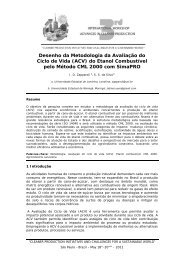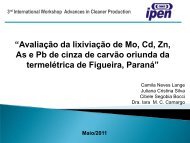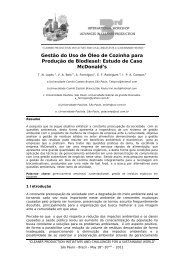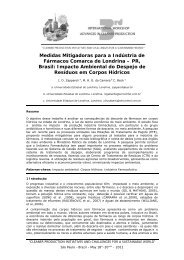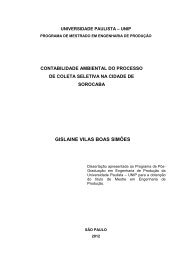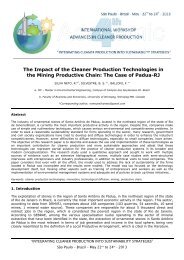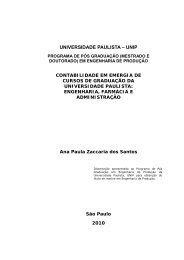Emergy as a tool for Ecodesign - Advances In Cleaner Production
Emergy as a tool for Ecodesign - Advances In Cleaner Production
Emergy as a tool for Ecodesign - Advances In Cleaner Production
You also want an ePaper? Increase the reach of your titles
YUMPU automatically turns print PDFs into web optimized ePapers that Google loves.
C.M.V.B. Almeida et al. / Journal of <strong>Cleaner</strong> <strong>Production</strong> 18 (2010) 32–43 35<br />
quantities of different resources required and emissions and w<strong>as</strong>tes<br />
generated per functional unit of a given system. There are also<br />
public datab<strong>as</strong>e initiatives, industry datab<strong>as</strong>es initiatives and LCA<br />
dedicated softwares, which cover the more commonly used goods<br />
and services <strong>for</strong> a number of products and processes [66].<br />
LCIs commonly include the main raw materials and the use of<br />
water and energy, and special emph<strong>as</strong>is is given to the emissions<br />
rele<strong>as</strong>ed to the environment. <strong>Emergy</strong> accounting refers to the use of<br />
resources to produce a good or a service. It is worthy to mention<br />
that at the design ph<strong>as</strong>e of a given product, the designer using<br />
emergy accounting would be able to consider not only the<br />
resources used <strong>for</strong> operating the production life cycle, but also all<br />
materials, human labor and energy to implement and operate the<br />
production process. Data referring to the system rele<strong>as</strong>es may be<br />
also used to calculate the environmental services required <strong>for</strong><br />
absorbing, diluting or decomposing these emissions and w<strong>as</strong>tes.<br />
But, it is worthy to attention that, at the design ph<strong>as</strong>e, data relative<br />
to emissions may only be estimated.<br />
The interactions of each stage of PET bottles and aluminum cans<br />
production with the <strong>Ecodesign</strong> activity may be established<br />
throughout the product’s life cycle stages (Fig. 2). From these<br />
interactions, the designer gets important in<strong>for</strong>mation <strong>for</strong> the<br />
development of the product or <strong>for</strong> the improvement of its environmental<br />
per<strong>for</strong>mance. It is important to note that designer’s<br />
power to make changes in both production life cycles lies on the<br />
manufacture stage. However, his actions may indirectly affect the<br />
life cycle, both upstream and downstream.<br />
The following are the steps recommended <strong>for</strong> designers <strong>for</strong><br />
evaluating a system with emergy accounting using data collected<br />
from the literature:<br />
1. Get a data set from the literature, from public, industrial or<br />
academic source.<br />
2. Draw an energy diagram, which helps to convert mental/verbal<br />
models to quantitative energy fluxes and to visualize the<br />
interactions among production stages.<br />
3. Set up an emergy evaluation table with a line item <strong>for</strong> each<br />
input.<br />
4. Multiply the amount relative to each flow by its respective<br />
emergy/unit or trans<strong>for</strong>mity to get the total emergy flow per<br />
functional unit.<br />
5. For interpretation, calculate the emergy indices. <strong>In</strong> this work,<br />
ELR is calculated in order to <strong>as</strong>sess the environmental load of<br />
the product, but there are other indices which may help<br />
designers to <strong>as</strong>sess the benefits of the economic use of an<br />
environmental resource, <strong>for</strong> example. For further in<strong>for</strong>mation<br />
see Ref. [64].<br />
6. To compare products or processes or to evaluate process’<br />
improvements, calculate the trans<strong>for</strong>mity or the emergy/unit of<br />
each product/process. The use of the product ELR emergy/FU<br />
and the ratio of ELR with the emergy per functional unit may<br />
lead to more complete and reliable results.<br />
To illustrate the use of the emergy accounting and the calculations<br />
<strong>for</strong> ELR, an LCI found in the literature [67,68] w<strong>as</strong> taken. This<br />
example w<strong>as</strong> chosen in order to enlighten the use of a literature<br />
data set and the use of quantitative results provided by emergy<br />
accounting during the product development. The selected LCI<br />
[67,68] compares beverage packages produced with PET and<br />
aluminum using virgin and recycled materials.<br />
2.3. C<strong>as</strong>e study<br />
The LCIs of PET bottles and aluminum cans were taken <strong>as</strong><br />
a Brazilian c<strong>as</strong>e study, and LCI in<strong>for</strong>mation is b<strong>as</strong>ed on literature<br />
data. A detailed description of the system, including the complete<br />
life cycle inventory data, can be consulted from Valt [67,68]. This<br />
approach w<strong>as</strong> used to <strong>as</strong>sess not only production systems and<br />
product options, but principally to aid designers to decide among<br />
materials alternatives, and to <strong>as</strong>sess changes and improvements in<br />
each production process.<br />
The inventory tables include the use of raw material, energy<br />
consumption, the use of semi-manufactures and auxiliary materials,<br />
and transport at each life cycle stage. Values of emergy per<br />
unit are shown in Table 1. Because of the size of the system, which<br />
covers several Brazilian States in both production and recycling<br />
stages, the type of the inputs <strong>for</strong> each flow w<strong>as</strong> chosen considering<br />
Brazilian boundaries. Crude oil and bauxite are then considered<br />
non-renewable inputs and water a renewable input. The quantity of<br />
recycled PET <strong>as</strong>sumed (40% in weight) is in agreement with Brazilian<br />
[69] and Mercosur [70] regulations. The quantity of recycled<br />
aluminum (80% in weight) is that practiced in the country in the<br />
same year [67]. The functional unit (FU) is 1000 L of beverage corresponding<br />
to 500 PET bottles of 2 L, and to 2857 aluminum cans.<br />
Diesel spent <strong>for</strong> transporting materials between stages w<strong>as</strong> taken<br />
into account <strong>as</strong> distances exceed 1000 km (Fig. 3).<br />
3. Results<br />
3.1. PET bottles production<br />
System diagrams illustrated in Figs. 4 and 5 were drawn to<br />
combine in<strong>for</strong>mation about the system of interest and the LCI<br />
inventory [67,68]. The energy diagram ensures that all driving<br />
energies included in the PET life cycle inventory were taken into<br />
account. Fig. 4 shows the diagram <strong>for</strong> PET production from virgin<br />
materials, and Fig. 5 includes the recycling stage <strong>for</strong> producing PET-<br />
R bottles. Both diagrams were used to construct tables of data<br />
required <strong>for</strong> the emergy accounting.<br />
As shown in Figs. 4 and 5, PET production operating inputs <strong>for</strong><br />
1000 L of beverage (electricity, materials, and fuels <strong>for</strong> transportation),<br />
<strong>as</strong> well <strong>as</strong> direct and indirect environmental inputs<br />
(water), are quantified in Tables 2 and 3, accordingly to the LCI data<br />
[67,68], <strong>as</strong>signed a suitable emergy per unit and converted to<br />
emergy values.<br />
The calculated emergy per 1000 L of beverage of the PET bottle<br />
production life cycle is 9.26 10 14 sej/FU, while the emergy per<br />
m<strong>as</strong>s of the finished bottle is 3.70 10 10 sej/g (Table 2). 93% of the<br />
total emergy invested <strong>for</strong> PET bottles production is <strong>as</strong>sociated to the<br />
first two life cycle stages. The major contributions to the total<br />
emergy are related to electricity (71%, being 30% sej/sej <strong>as</strong>sociated<br />
to petroleum extraction and 41% sej/sej to crude oil refining), and to<br />
the crude oil used <strong>as</strong> raw material (14% sej/sej). It is interesting to<br />
mention that in Brazil 95% of the electric energy is obtained from<br />
hydroelectric plants [76], and that this kind of energy h<strong>as</strong><br />
Table 1<br />
Values of emergy per unit and trans<strong>for</strong>mities used in this work.<br />
Item Type a <strong>Emergy</strong> per unit References<br />
(sej/g)<br />
(sej/J)<br />
River water R 2.03 10 5 4.26 10 4 [71]<br />
Methanol F 4.80 10 4 [72]<br />
Coke F 5.40 10 4 [73]<br />
Crude oil N 5.54 10 4 [74]<br />
Diesel (transport) F 6.60 10 4 [64]<br />
Electric energy F 1.65 10 5 [64]<br />
Bauxite N 8.55 10 8 [64]<br />
Chemicals F 2.65 10 9 [75]<br />
Paint and varnish F 3.00 10 9 [61]<br />
a Types of inputs were cl<strong>as</strong>sified accordingly to the boundaries set to the system.




